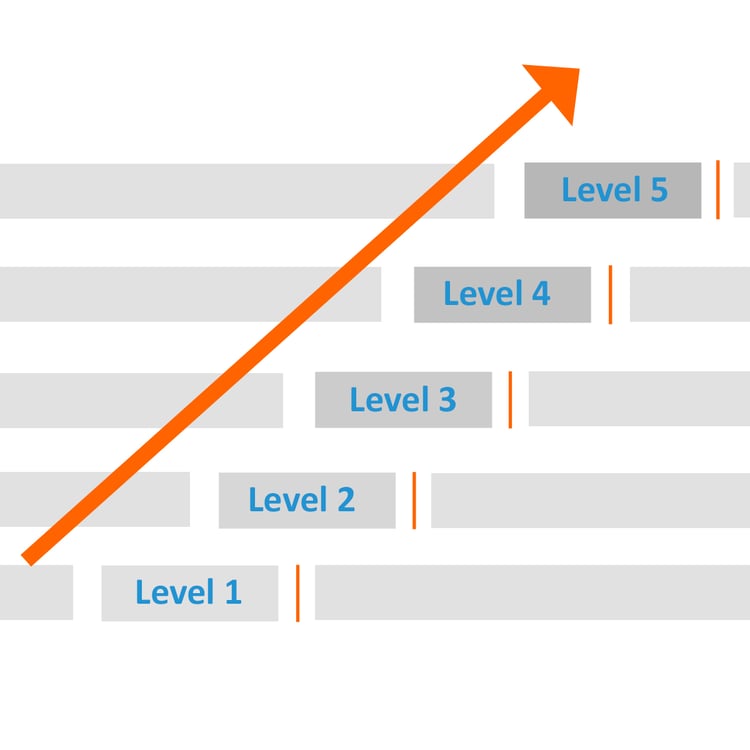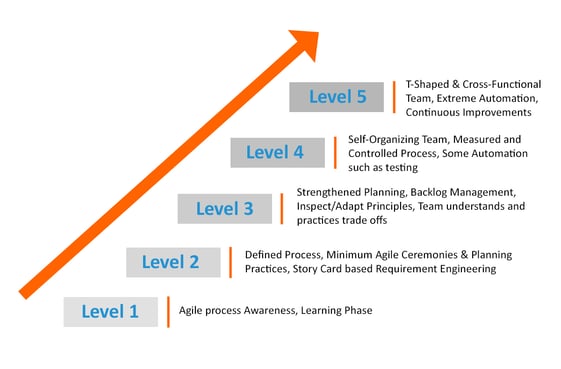
As a Senior Scrum Master, I’ve worked with many organizations, and I’m frequently asked by leaders one common question: how long will it take for my team to be Agile? The answer is never easy; developing an Agile mindset can be complex. From senior executives to developers, everyone in the organization must be open-minded and willing to change. Of course, there will always be resistance, but this can be handled through open dialogue and continual conversation.
I’d like to walk through a staged representation depending upon the maturity levels that each team goes through in becoming Agile. The information you can gather from the maturity levels is an important metric that organizations are intrigued and excited to see because they show progress in their Agile journey. I have used the maturity levels extensively with teams, and it’s always great to show progress; but remember, it’s just a tool.
So, with that being said, let’s get started. I will review each maturity level a team goes through, and along the way, I’ll share my perspective and lessons learned.

Level 1 is a Learning Phase. As teams get started on their Agile journey, it’s essential to introduce and establish an Agile mindset. From my experience, an Agile Boot Camp is a great way to create this awareness and introduce some initial concepts. It’s also an opportunity to see the team composition, make introductions, and begin a new way of working together. While Level 1 focuses on awareness, you can’t short-change the importance of this initial step; it sets the foundation for the beginning of the journey and the team’s future success.
To reach Level 2, teams must have a solid understanding of what it means to be Agile, and they must also recognize there is a difference between Agile and Scrum/Kanban. Frequently, I hear teams using words like Agile and Scrum interchangeably; and it’s important everyone understands that Agile is a methodology, whereas Scrum and Kanban are different frameworks of Agile. The Agile ceremonies or events should be scheduled with a set agenda and teams should practice story card-based requirement gathering.
Once the team has a firm grip on what it means to be Agile, they’re practicing the events, using terms correctly, and understanding the different frameworks; it’s time to move to Level 3, where the focus is on proper planning, practicing trade-offs, backlog management, and inspect/adapt principles. Better planning is your key to executing a sprint well. Having a solid backlog and adopting inspect/adapt principles will play a crucial part in a team’s success. The team should be encouraged and start to practice trade-offs.
As a Scrum Master and coach, I continually talk with my teams about embracing change. As they transition from Waterfall to Agile, the team should practice the “yes, I can, but…” phrase. For example, the Product Owner issues a new requirement, but the team already has a full plate of work. At this point, the team should be willing to practice a trade-off, accepting the requirement but be open to a conversation with the Product Owner to reprioritize existing items. Through this process, we ensure change is embraced and simultaneously practice trade-offs to not burn out the team.
As we move up the ladder, Level 4 is about the team starting to self-organize. In the planning session, there is a discussion about the sprint goals and stories, and the team should be able to self-organize and pick up the tasks that will help them achieve the sprint goal. Remember – it’s team commitment, not individual commitments, that matter. The team should be able to start measuring the process and looking at ways to improve, such as introducing some automation in the form of testing.
Level 5 focuses on improving T-Shaped skills, which can be attained by having a buddy-pair system within the team. Through this process, knowledge is gained and shared across teammates, thereby ensuring the team becomes cross-functional as time progresses. Teams will now be experienced looking at extreme automation techniques like RPA and AI, developing CI/CD pipelines, and eventually working in a DevOps model.
In conclusion, an Agile Transformation begins with a people mindset. While we looked at the Agile Transformation Maturity levels, it’s important to understand the effort put in by all players within an organization. From developers to Product Owners to Agile sponsors, everyone plays a role in achieving a successful Agile Transformation. As your organization moves through the different levels, remember, it’s going to be a bumpy ride. There will be forward momentum as well as setbacks; hence, it takes time. But as a Scrum Master who has worked with teams on their transformation journey, moving through the different maturity levels is a process, but the result is worth it.
More from the blog
View All Blog PostsSubscribe to Our Blog
Fill out your email address to receive notifications about new blog posts from CC Pace!

